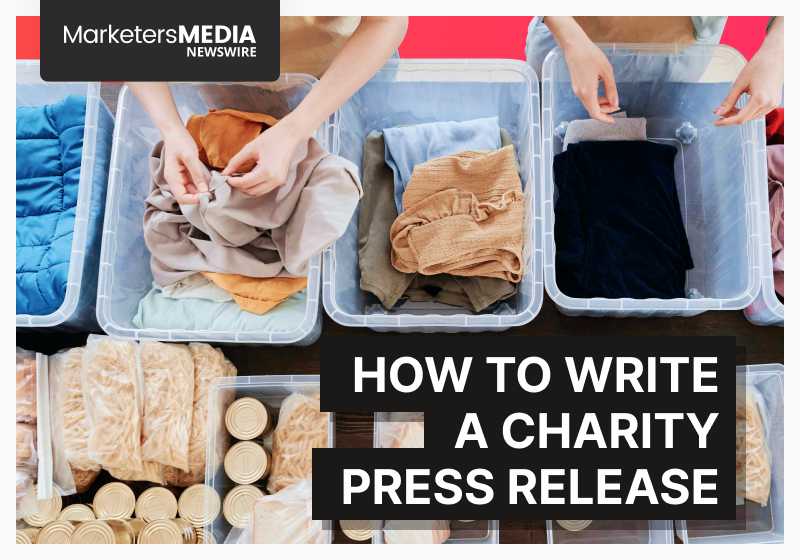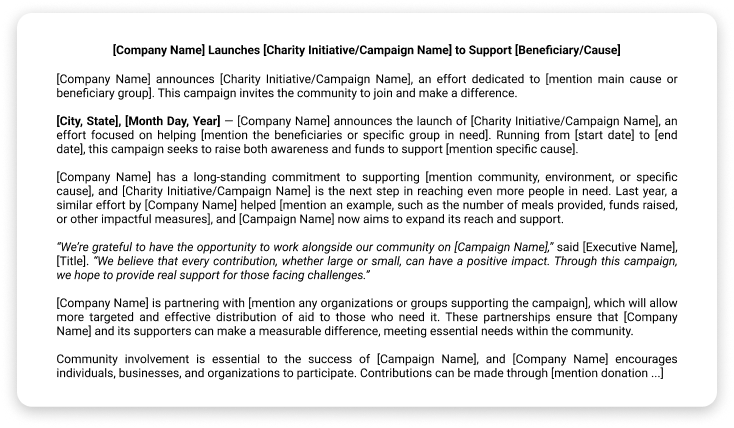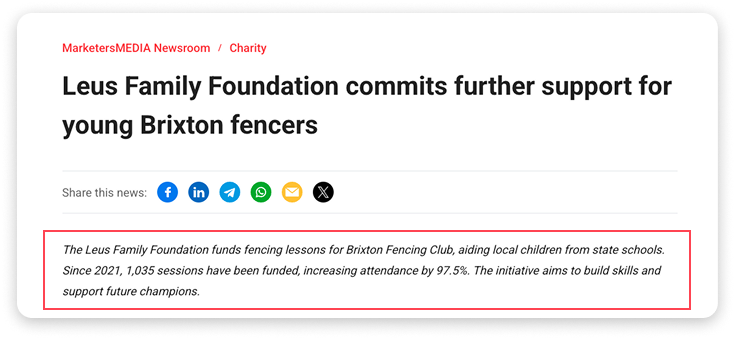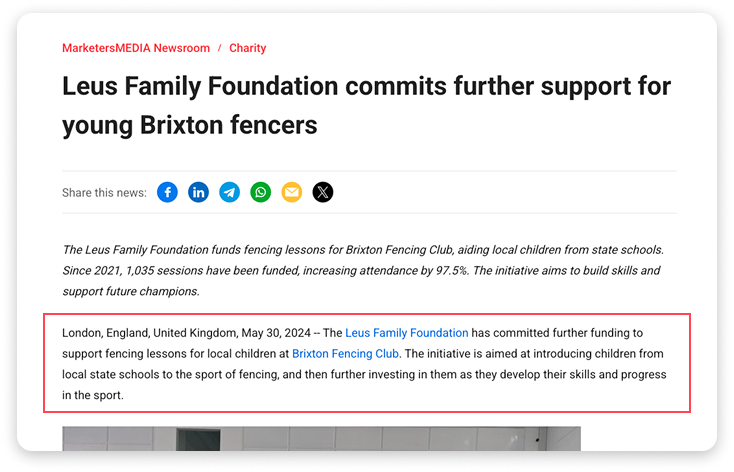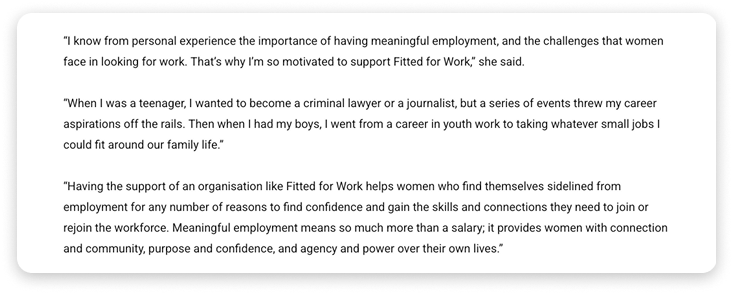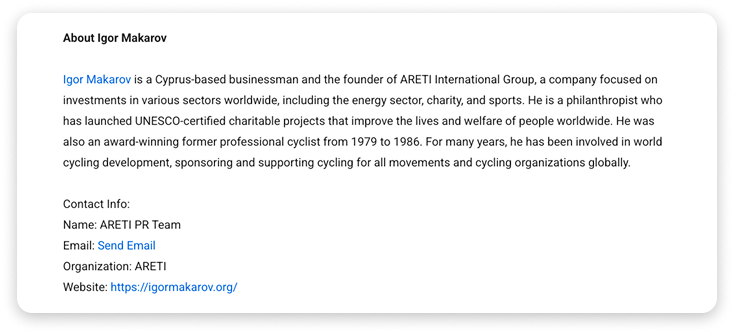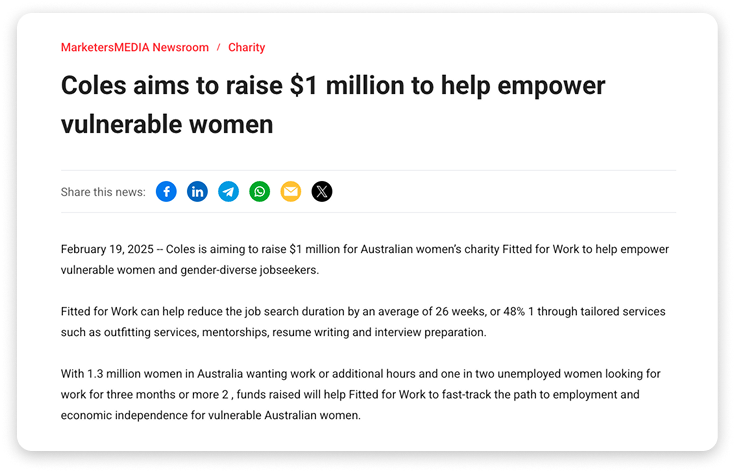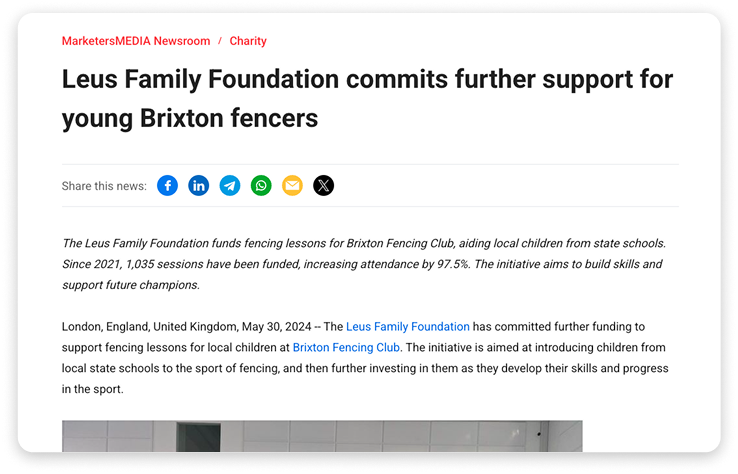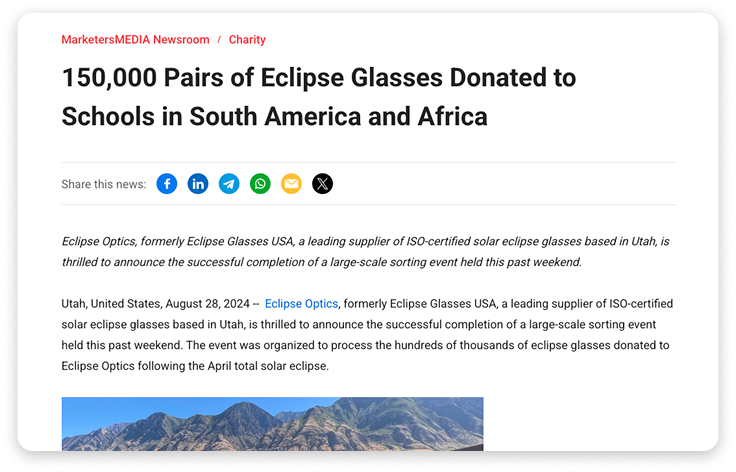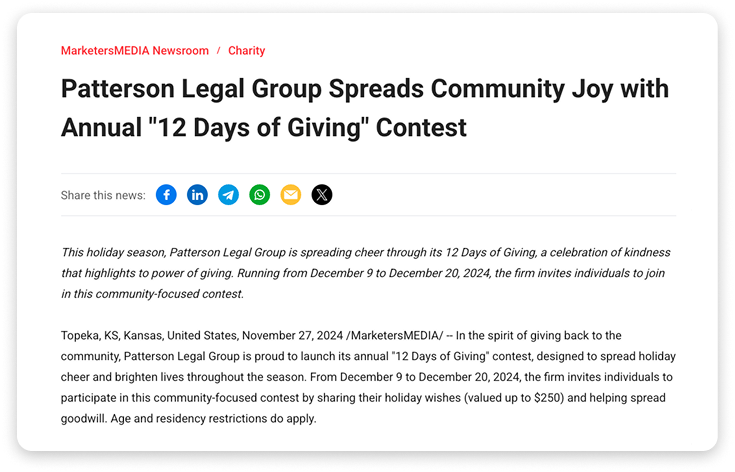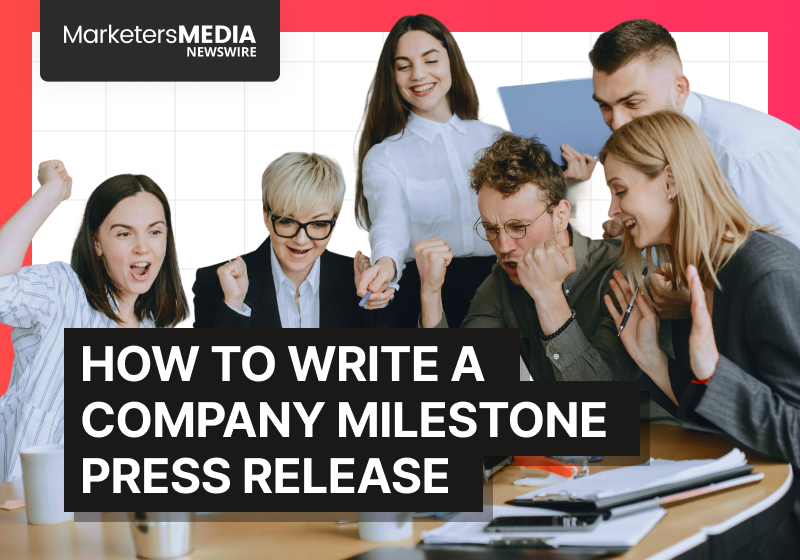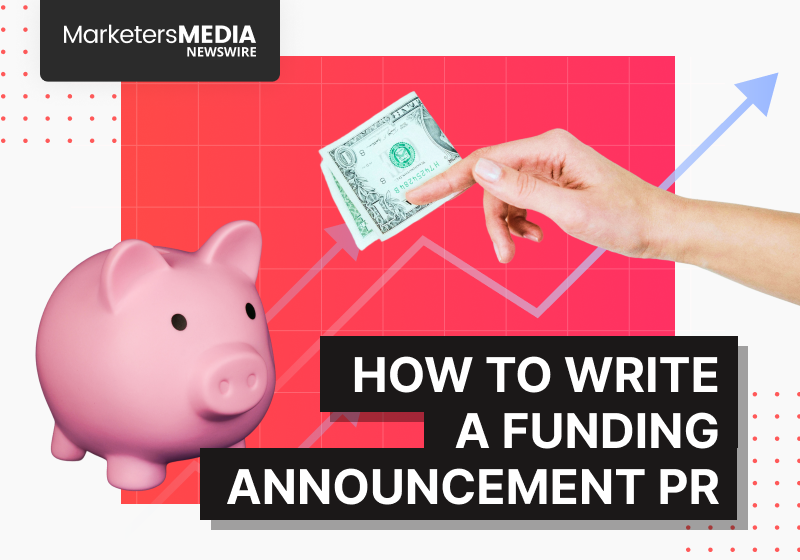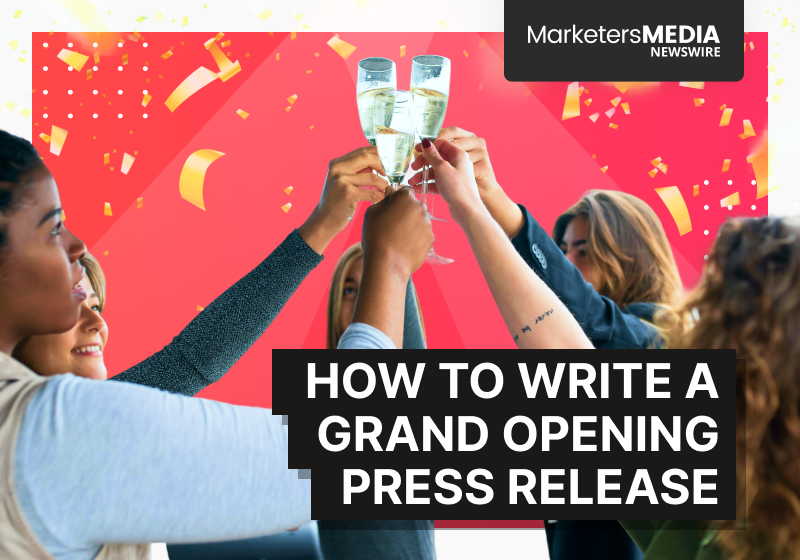Giving back feels good. But telling people about it—clearly, simply, and with enough heart—can do even more.
When you write a charity press release the right way, it helps people see what your company cares about. It shows you're not all business, and it gives your audience something to root for. Customers are naturally drawn to companies that do good. And industry folks? They’re paying attention too.
It’s also helpful for the cause itself. A well-timed press release can give a nonprofit more visibility, more support, and a better shot at meeting their goals. So it’s a win all around.
If you’re not sure where to start, don’t worry—we’ve got a simple template you can follow.
Charity Press Release Template (Free Download)
When Should You Send a Charity Press Release?
Not every kind gesture needs a headline, but if your company is supporting a cause in a meaningful way, it’s worth sharing. A press release makes the moment bigger, and it helps rally others to the cause.
Here are some of the best times to send one:
- You’re launching a fundraising campaign or charity initiative
- You’ve partnered with a nonprofit or pledged a donation
- You’re hosting a community event, fundraiser, or volunteer drive
- You’ve reached a major milestone—like raising a specific amount or helping a certain number of people
- You’re matching donations from customers or the public
Ideally, send your press release before the event or campaign begins so media outlets have time to cover it. For donations or milestones, send it soon after the achievement to keep the momentum going.
What to Include in Your Charity Press Release
Now that you know when to send it—whether it’s a community campaign or a donation press release—let’s talk about what goes in it.
Like any other press release, it follows a standard format—but with a charity or donation press release, you also want to bring out the heart behind the action. Why this cause? Why now? Why should someone care?
Let’s walk through each part:
Headline
Your headline is the first thing that readers will see, so don’t waste this valuable real estate. A short, compelling, action-oriented headline goes a long way to either give the gist of the press release while getting people intrigued.
Example:
Testing several different headlines is the only way to find out what works best with your audience. Paint a vivid picture, elicit an emotional response, and incite the reader’s curiosity to get them to click!
Summary
One or two short sentences that give the full picture at a glance. Think of it as the “so what?”—why this moment matters, and what readers should know right away.
Example:
Dateline
The dateline sets the scene for when/where your news story is taking place.
Example: Los Angeles, CA – October 30, 2025
Lead Paragraph
Start with a strong opening that covers the who, what, when, where, and why in the first few sentences. This paragraph should stand alone to give readers the most important information.
Example:
- Who: The Leus Family Foundation
- What: Committed further funding to support fencing lessons.
- When: May 30, 2024
- Where: London, England, United Kingdom (specifically Brixton Fencing Club)
- Why: To introduce children from local state schools to fencing and invest in their development.
Body Paragraph
This is where you bring the story to life. While the lead paragraph gives the essentials, the body brings depth, emotion, and impact.
Instead of just listing what happened, this section should answer: Why does this initiative matter? Who does it help? What’s the real impact?
#1 Your "Why": What Motivated the Effort
Start by explaining why your company chose to support this cause. Was it part of an ongoing commitment, a response to a pressing need, or a way to give back to the community? If there’s a personal or company-driven motivation, mention it. People connect with purpose, not just action.
#2 The Impact: What the Effort Accomplished
Then, highlight the impact in concrete terms. Numbers and details make a difference:
- How much was donated? If it’s funding, mention the amount.
- How many people will benefit? Be as specific as possible.
- What measurable difference has it made? Compare before and after.
- How does this fit into a bigger goal? If this is part of a long-term effort, mention that too.
For example, instead of saying “The company supported children’s sports,” say:
"Since 2021, the initiative has funded 1,035 fencing lessons, leading to a 97.5% increase in participation among local students.”
#3 Human Stories
Facts give people clarity, but stories give them something to hold onto. If possible, include a short anecdote from someone directly impacted by the initiative:
- A student who discovered a passion for fencing.
- A parent grateful for the program’s opportunities.
- A nonprofit leader explaining the difference this funding makes.
Even one sentence can add emotional weight: “Before joining the program, 12-year-old Alex had never picked up a fencing saber. Now, he dreams of competing professionally.” (P.S. Always ensure you have permission before sharing personal stories.)
#4 Quotes from Leadership
A well-placed quote from leadership reinforces credibility and adds a personal touch. Choose a genuine, natural statement instead of something overly polished.
Just look at how the Fitted for Work press release used quotes from Julie Goodwin, a public figure who has lived experience with employment challenges.
Instead of generic praise, she shares how her career path was shaped by real struggles, and why the cause matters to her personally.
That’s the kind of quote that sticks with people—and makes the story resonate beyond the headline.
#5 Call to Action
Finally, Wrap up the body section by letting people know how they can take part.
What should readers do next?
- If the initiative is ongoing, provide a link for donations or volunteer opportunities.
- If it’s an event, share how people can attend or support it. Make it easy for people to get involved.
Example:
“To support the program, visit the foundation’s donation page or contribute by April 15.”
Boilerplate and Contact Information
At the end of the release, include a short paragraph about your business and (if applicable) the nonprofit. This is your “about us” section—keep it factual, consistent, and low-key.
Finally, add a name, email, and phone number. If a journalist or partner wants to cover the story or follow up, you want to be easy to reach.
You don’t have to overthink it. Just be clear, be real, and let the purpose behind the press release shine through.
Example:
Remember to keep it concise—aim for one page, two at most. Journalists and readers appreciate when you respect their time by getting straight to the point.
Tips for Writing Effective Charity Press Releases
Writing a press release that actually gets picked up requires a bit of strategy:
Focus on newsworthiness: Ask yourself, "Would someone outside our company care about this?" If the answer isn't an immediate yes, rethink your angle.
Keep it authentic: Avoid sounding like you're just bragging about your good deeds. Focus on the cause and the impact instead of corporate self-promotion.
Skip the jargon: Write in plain language that anyone can understand, not corporate speak or industry terms.
Leverage social proof: If other notable businesses or community leaders support your cause, mention it. Social validation helps readers trust your initiative.
Add multimedia elements: Including quality photos, infographics, or video links can make your press release stand out.
Send to the right people: Research which journalists and publications cover charity news, corporate social responsibility, or your specific cause.
Distribute beyond media outlets: Send your press release directly to community groups, business networks, and industry associations that might have interest in your cause.
Plan for follow-up content: Your press release is just the beginning. Have blog posts, social media content, or video ready to maintain momentum once your story gets attention.
The most successful charity press releases feel genuine. Readers can tell when a company truly cares versus when they're just checking a PR box.
Charity Press Release Examples
Press Release Example #1
Coles teamed up with Fitted for Work, an Australian charity that helps women and gender-diverse people find meaningful employment. The campaign aimed to raise up to $1 million by donating a portion of sales from selected in-store and online products.
Why this press release works:
- It shares a clear, measurable goal upfront—$1 million is easy to understand and gets attention.
- The press release explains the real-world outcome of that goal: up to 1,400 women could get job-ready through tailored services.
- It includes context about unemployment and job-seeking struggles in Australia, making the “why” feel urgent and important.
- Quotes from both Coles and Fitted for Work—and especially from ambassador Julie Goodwin—feel human and personal. Her story adds depth and creates an emotional connection.
This one balances corporate participation with social impact really well. It doesn’t feel like Coles is patting itself on the back—it feels like a genuine effort to help.
Press Release Example #2
The Leus Family Foundation committed more funding to provide free fencing lessons for children from local state schools through Brixton Fencing Club. This initiative had already been running since 2021 and showed strong growth.
Why this press release works:
- It includes specific numbers—1,035 lessons funded and a 97.5% jump in attendance—which show tangible progress.
- It mentions the program’s founder and the ongoing relationship with the fencing club, giving it a strong sense of continuity.
- There’s a nice mix of benefits: athletic development, confidence-building, and even competitive success among participants.
- The quotes feel thoughtful. Dmitry Leus shares how the mission has grown—from building life skills to now supporting future champions.
What’s nice here is that it focuses on the kids and the journey—not just the funding. That’s the kind of story people remember.
Press Release Example #3
Eclipse Optics donated 150,000 pairs of eclipse glasses to schools in South America and Africa, giving students a safe way to view upcoming solar eclipses. The effort was part of an Eagle Scout project that brought together over 100 volunteers.
Why this press release works:
- The donation is unique, visual, and practical—perfect for headlines and social sharing.
- It highlights the scale of the impact with a simple number: 150,000 students across two continents.
- There’s a feel-good layer with the youth leadership angle—Kobi Bons, an Eagle Scout, helped organize the sorting event.
- The release also thanks volunteers and donors, turning it into a community moment rather than a solo company announcement.
It’s a great reminder that charity press releases don’t always have to focus on money. In-kind donations can be just as newsworthy.
Press Release Example #4
This law firm runs a yearly holiday contest where community members can submit wishes valued up to $250. The contest is paired with other giving efforts, like turkey giveaways and donations to local nonprofits.
Why this press release works:
- It’s hyper-local and seasonal, which gives it a timely angle.
- Instead of focusing on a one-time donation, it highlights a pattern of giving—including thousands in charitable donations and community events.
- The language is upbeat and positive without being overdone.
- It closes with a clear CTA, encouraging people to get involved and share their stories.
Even small businesses can make a big impression with consistency and heart. This release shows how giving back year-round—not just during the holidays—can become part of a brand's identity.
Wrapping Things Up
Charity press releases don’t have to be complicated, but they do need to be thoughtful. A donation press release, a local giving campaign, or even an in-kind contribution can all make an impact when the story is shared with clarity and care.
Use the examples above for ideas, follow the structure, and focus on the outcome your support creates. A well-timed release can bring in more support, raise visibility for the cause, and show people what your business stands for.
If you're also planning to highlight your company’s ongoing responsibility efforts, check out this post on writing a CSR press release. It walks through the structure, message, and real examples to help you get started.
Free Press Release Template
Tell us where to send your PDF:
